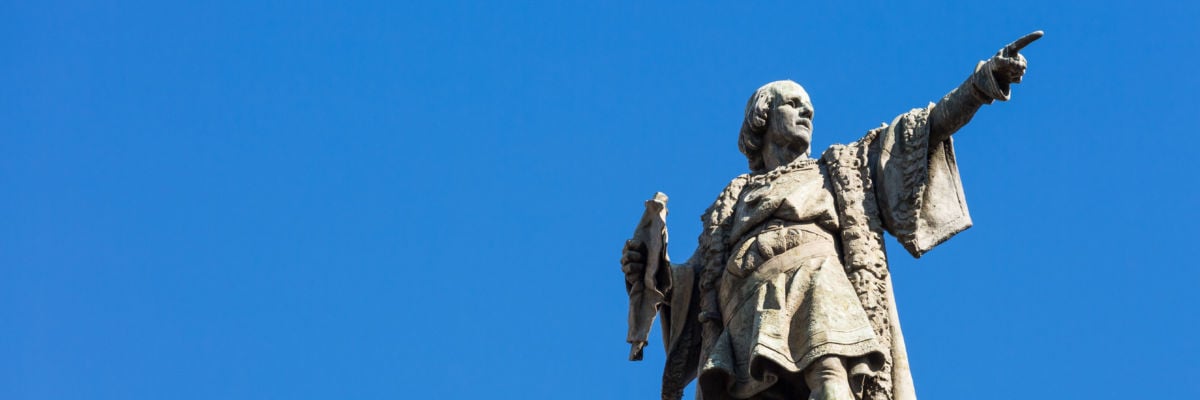
Editor’s note: As time passes, controversy over the historical Western project to explore, colonize, and Christianize the Americas and other non-European lands seems only to grow—bound up with heightened cultural and political preoccupations, both sincere and cynical, with issues of race, tolerance, and diversity. Of this controversy, Columbus has, sadly but unavoidably, become an icon and a lightning rod. In consideration of this, the author has revised and lengthened this article in an attempt, not to anticipate and refute every charge leveled against Columbus (which would require a much longer work) but at least to bring more nuance to a historical figure whose flaws do not fit into a simple category. And who, on balance, we may yet celebrate as a doer of great good.
In popular myth, Christopher Columbus is the symbol of European greed and genocidal imperialism. In reality, he was a dedicated Christian concerned first and foremost with serving God and his fellow man.
Peering into the future, Columbus (1451-1506) could not have anticipated the ingratitude and outright contempt shown by modern man toward his discovery and exploration of the New World. It has become fashionable to view him not as a devout Catholic concerned for the eternal salvation of the indigenous peoples he encountered but rather as deliberately genocidal: a symbol of European imperialism1 and a bringer of destruction, enslavement, and death to the happy and prosperous people of the Americas.2
In the United States, the vitriol directed against Columbus produces annual protests every Columbus Day. Some want to abolish it as a federal holiday, and a growing number of cities and states already refuse to acknowledge it and celebrate instead “Indigenous Peoples Day.”3
This movement to brand Columbus a genocidal maniac and erase all memory of his extraordinary accomplishments stems from a false myth about the man and his times.
The so-called Age of Discovery was ushered in by Prince Henry the Navigator (1394-1460) of Portugal. Prince Henry and his sailors inaugurated the great age of explorers finding new lands and creating shipping lanes for the import and export of goods, including consumables never before seen in Europe. Their efforts also created an intense competition among the sailing nations of Europe, each striving to outdo the others in finding new and more efficient trade routes. It was into this world of innovation, exploration, and economic competition that Christopher Columbus was born.
A native of the Italian city-state of Genoa, Columbus became a sailor at the age of fourteen. He learned the nautical trade sailing on Genoese merchant vessels and became an accomplished navigator. On a long-distance voyage past Iceland in February 1477, Columbus learned about the strong east-flowing Atlantic currents and believed that a journey across the ocean could be made because the currents would be able to bring a ship home.4 So Columbus formulated a plan to seek the east by going west. He knew that such an ambitious undertaking required royal backing, and in May of 1486, he secured a royal audience with King Fernando and Queen Isabel of Spain, who in time granted everything Columbus needed for the voyage.
On August 3, 1492, Columbus embarked from Spain with ninety men on three ships: the Niña, Pinta, and Santa Maria.5 After thirty-three days at sea, Columbus’s flotilla spotted land (the Bahamas), which he claimed in the name of the Spanish monarchs. Columbus’s modern-day detractors view that as a sign of imperial conquest. It was not—it was simply a sign to other European nations that they could not establish trading posts on the Spanish possession.6
On this first voyage, Columbus also reached the islands of Cuba and Hispaniola. He stayed four months in the New World and arrived home to fanfare on March 15, 1493. Unfortunately, the Santa Maria ran aground on Hispaniola so was forced to leave forty-two men behind, ordered to treat the indigenous people well and especially to respect the women.7 But as Columbus discovered on his second voyage, that order was not heeded.
Columbus made four voyages to the New World, and each brought its own discoveries and adventures. His second voyage included many crewmen from his first, but also some new faces such as Ponce de León, who later won fame as an explorer himself. On this second voyage, Columbus and his men encountered the fierce tribe of the Caribs, who were cannibals, practiced sodomy, and castrated captured boys from neighboring tribes. Columbus recognized the Caribs’ captives as members of the peaceful tribe he met on his first voyage, so he rescued and returned them to their homes.8 This voyage included stops in Puerto Rico and the Virgin Islands.
The third voyage was the most difficult for Columbus, as he was arrested on charges of mismanagement of the Spanish trading enterprise in the New World and sent back to Spain in chains (though later exonerated). Columbus’s fourth and final voyage took place in 1502-1504, with his son Fernando among the crew. The crossing of the Atlantic was the fastest ever: sixteen days. The expedition visited Honduras, Nicaragua, and Costa Rica, and was marooned for a time on Jamaica.
Most accounts of Columbus’s voyages mistake his motives by focusing narrowly on economic or political factors. But in fact, his primary motive was to find enough gold to finance a crusade to retake Jerusalem from the Muslims, as evidenced by a letter he wrote in December 1492 to King Fernando and Queen Isabel, encouraging them to “spend all the profits of this my enterprise on the conquest of Jerusalem.”9 In this, he believed he was fulfilling conditions for the Second Coming of Christ. Near the end of his life, he even compiled a book about the connection between the liberation of Jerusalem and the Second Coming.10
Columbus considered himself a “Christ-bearer” like his namesake, St. Christopher.11 When he first arrived on Hispaniola, his first words to the natives were, “The monarchs of Castile have sent us not to subjugate you but to teach you the true religion.”12 In a 1502 letter to Pope Alexander VI (r. 1492-1503), Columbus asked the pontiff to send missionaries to the indigenous peoples of the New World so they could accept Christ. And in his will, Columbus proved his belief in the importance of evangelization by establishing a fund to finance missionary efforts to the lands he discovered.13
Contrary to the popular myth, Columbus initially treated many of the native peoples with great respect and friendship. He was impressed by their “generosity, intelligence, and ingenuity.”14 He recorded in his diary that “in the world there are no better people or a better land. They love their neighbors as themselves, and they have the sweetest speech in the world and [they are] gentle and always laughing.”15 Columbus demanded that his men exchange gifts with the natives they encountered and not just take what they wanted by force. He enforced this policy rigorously: on his third voyage in August 1500, he hanged men who disobeyed him by harming the native people.16
Columbus did not sail to the New World with the intention of enslaving native peoples he might encounter. His views about the native peoples changed over the course of his multiple voyages based on his interaction with the various tribes and with the, at times, unruly Spanish settlers. Though a brilliant sailor and navigator, and a fearless explorer, he was not an able administrator. Columbus did view certain tribes (the Cairbs in particular) as combatants, and under the conventions of the day, subject to just-title slavery. However, his primary intention was that the natives, who worked in the Spanish settlement in Hispaniola, be considered employees of the crown.17 In further proof that Columbus did not plan to rely on slave labor, he asked the crown to send him Spanish miners to mine for gold.18 Indeed, the Spanish monarchs in their instructions to Spanish settlers mandated that the Indians be treated “very well and lovingly” and demanded that no harm should come to them.19 Sadly, this admonition was not always practiced.
Columbus was a complex man and his actions in the New World reflected the complexities of his experiences and the time in which he lived. He was neither the saint nor the barbarian portrayed by different groups with their own agendas in the modern world. Columbus passed to his eternal reward on May 20, 1506.
For more on European exploration and missionary activity in the New World, or to learn the facts about many other anti-Catholic historical myths, check out Steve Weidenkopf’s book, The Real Story of Catholic History, available from Catholic Answers Press.
1 Carol Delaney, Columbus and the Quest for Jerusalem (New York: Free Press, 2011), xii.
2 See http://www.transformcolumbusday.org/.
3 Marilia Brocchetto and Emanuella Grinberg, “Quest to Change Columbus Day to Indigenous Peoples Day Sails Ahead,” CNN.com, October 10, 2016, accessed April 7, 2017, http://www.cnn.com/2016/10/09/us/columbus-day-indigenous-peoples-day/.
4 The sailors of Columbus’s day did not believe the earth was flat, as is commonly believed, but were afraid about the ability to get home after sailing across the ocean.
5 Columbus demanded a patent of nobility, a coat of arms, the titles of Admiral of the Ocean Sea and Viceroy and Governor of all discovered lands, plus 10 percent of the revenue from all trade from any claimed territory. Isabel agreed to these terms and both parties signed the Capitulations of Santa Fe on April 17, 1492. See Delaney, Columbus and the Quest for Jerusalem, 68.
6 See Delaney, Columbus and the Quest for Jerusalem, 92.
7 Ibid., 109.
8 Ibid., 130.
9 Ibid., vii.
10 The book was titled Libro de las Profecías or the Book of Prophecies.
11 Delaney, Columbus and the Quest for Jerusalem, 83.
12 Daniel-Rops, The Catholic Reformation, vol. 2, 27.
13 Ibid., 159.
14 Ibid., 97.
15 Columbus, Diario, 281. Quoted in Delaney, Columbus and the Quest for Jerusalem, 107. Columbus was a literate man, which was rare for the day. He recorded his observations of the New World in his diary and ship’s log, at a time when keeping logs was not standard practice.
16 See Delaney, Columbus and the Quest for Jerusalem, 181.
17 Ibid., 142.
18 Ibid., 153.
19 See Samuel Eliot Morison, trans. and ed., Journals and Other Documents on the Life and Voyages of Christopher Columbus, vol. 1 (New York: Heritage Press, 1963), 204. Quoted in Delaney, Columbus and the Quest for Jerusalem, 125-126.



